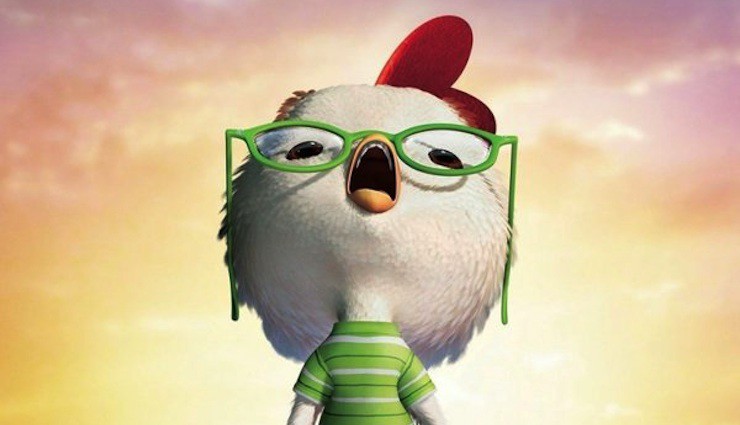“Crazy little chicken. We don’t make eye contact. Bye bye.”
I’ve kept my computer open while watching each and every film in this Read-Watch, frequently pausing to take notes. Sometimes extensive notes, sometimes short notes, sometimes notes that I’m completely unsure about even a day later—for instance, “rabbit pizza!” during The Black Cauldron, a note that still mystifies me. Sometimes long lines of incomprehensible gibberish, usually, but not always, a contribution from a cat. Sometimes I’m so enthralled that I forget to take notes, and then have to watch the film again. (You can weep for me.) Sometimes my notes are so extensive that the post is mostly done before the film.
And sometimes, my notes consist of this (edited because my mother reads these posts):
Holy $@%# is this a bad movie.
I WISH THE %&*#@$^ SKY WOULD FALL IN.
SOMEONE KILL THIS DUCK.
Wait, is she a duck?
Maybe not a duck.
KILL THE DUCK.
KILL THE DUCK.
It’s rare for a Disney film to inspire such violent thoughts from me, but, this film. This film.
Chicken Little (2005) was born out of a combination of cynicism and resignation. With the exception of Dinosaur (2000), then not regarded as a Disney Animated Classic, and Lilo and Stitch (2002), almost all of Disney’s most recent releases had been either box office disappointments or major box office disappointments. Even Lilo and Stitch had enjoyed an only moderate success at the box office. This was not, studio executives knew, because film audiences were tired of either animated films or Disney: rival Dreamworks and Pixar were producing smash hits. Disney animated films continued to be DVD bestsellers, and were soon to get another shot in the arm with the release of Blu-ray technology in 2006, which encouraged several people to upgrade their perfectly good DVDs with better quality Blu-rays, not that I personally would know anything about this sort of thing, ahem. Nor could it be blamed on the various groups calling for boycotts of Disney products. The Disney stores and theme parks had taken a hit after 9/11, but by 2002—just as Chicken Little entered development—both the theme parks and stores had started to recover from that dip. The just introduced Disney Princess franchise was a decided success. No. It wasn’t animation. It wasn’t—probably—the Disney brand. It had to be something else.
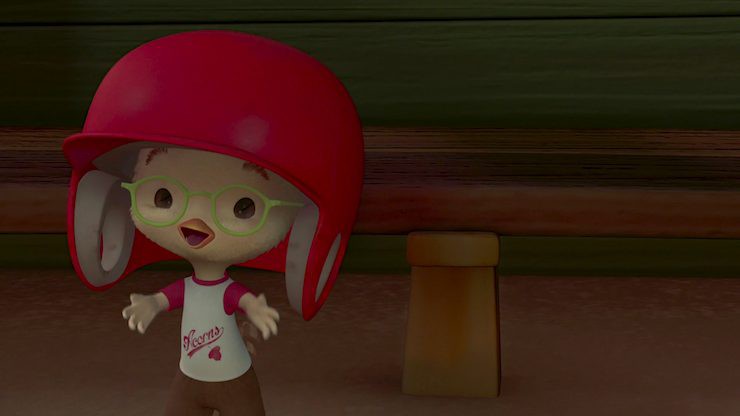
Roy E. Disney thought he knew what that something else was: then CEO Michael Eisner. Infuriated, Disney began his second Save Disney campaign in hopes of ousting Eisner from the board, a process that continued during most of the making of this film. Other Disney executives, with less of a grudge against Eisner, blamed something else: the costly hand animated process that, while producing often extraordinarily beautiful work (some scenes from Treasure Planet) did not necessarily drag in audiences (all scenes from Treasure Planet). These same Disney executives couldn’t help but notice that the cheaper computer animated processes used by rivals Pixar and Dreamworks were creating very financially successful films.
Why not, these executives asked, ignore the success of Lilo and Stitch and try out computer animation instead, especially since Disney had helped pioneer the technique in the first place? Especially since the partly computer animated Dinosaur was one of the few Disney success stories?
And so animators set out to create Chicken Little, Disney’s first 100% computer animated film.
Chicken Little starts off by mocking the openings of The Lion King, Cinderella, and Pinocchio, in a sequence that mostly serves to remind all of us that all three were much better films. A minute or so later, a giant ball is rolling through the town in a way strikingly like the scene where Indiana Jones has to flee the giant ball about to roll over him, something I noticed largely because, for some unknown reason, Chicken Little also chooses to include a brief clip of Raiders of the Lost Ark, a moment that largely serves to remind all of us that Raiders was also a much better film. And that this film is going to have issues: these are talking animals, who will later watch a film about talking animals, all of whom act entirely human, who here are watching a clip from a live action film featuring humans, and none of them comment on this discrepancy—is Raiders supposed to be the film’s in-universe version of cartoons?—because it’s supposed to be funny, and yet it isn’t.
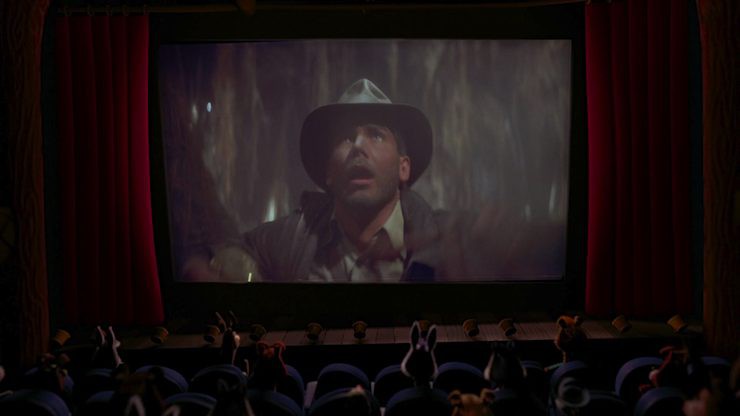
Anyway. From here, the film more or less moves into the main plot, which reportedly was originally conceived as the touching story of a little girl who panics a lot, but learns to overcome it. This was changed into the touching story of a little scrawny teenage chicken who just wants his huge hulking father chicken to be proud of him and doesn’t, frankly, overcome all that much. After Chicken Little warns the entire town that the sky is falling (this would be the “inspiration” from the initial fable) everybody is really really really mean to him and he goes through humiliation after humiliation until finally—finally—it occurs to him that the only way to earn his father’s approval and respect is to try out for the town baseball team, even though he’s so weak and scrawny he can’t even pick up a baseball bat. Fortunately, after some training help from his friends Abby (an Ugly Duckling), Runt (a pig who is mostly in the film to make jokes about fat people and Barbra Streisand), and Fish Out of Water (who zips around with a tank on his head), Chicken Little hits a ball, and, thanks to some frankly preposterous incompetence from the rival team, the little chicken manages to score a home run and the film ends there with everyone mostly bored but sorta satisfied.
Ha ha, I jest.
In actuality, Chicken Little and his father bond, and Chicken Little sings “We Are the Champions” (fast forward through this part) and then aliens show up.
Ha ha, I—no, actually, I’m no longer jesting. I wish I were.
This is about the moment when the film goes from moderately offensive and irritating but mostly boring, to unbelievably bad. It’s also, not coincidentally, about the moment when my notes started consisting mostly of SOMEONE KILL THE DUCK and KILL THE DUCK and WHY AREN’T THE ALIENS KILLING THE DUCK.
It was also the moment when I suddenly realized that yes, I had seen this film before. I’d just repressed the memories out of pain.
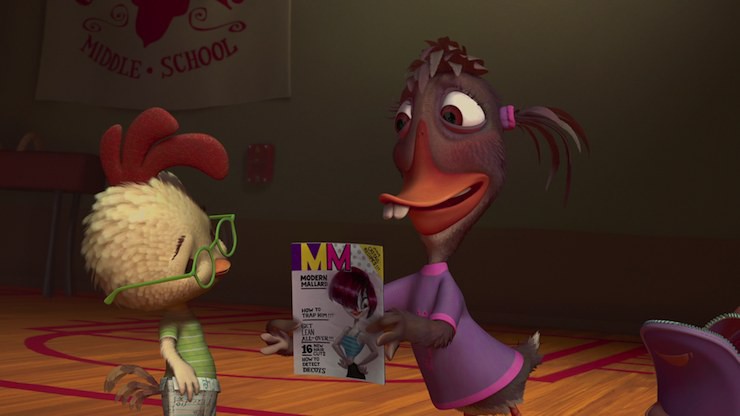
Anyway. Since I’ve mentioned the duck. Her name, as said, is Abby, and she’s an Ugly Duckling, voiced by the otherwise excellent Joan Cusack. Abby, after reading some quality duck zines (a joke that lands with a thud) decides that Chicken Little’s actual problem is not, say, regularly waking up too late, or using soda bottles as rockets, or the ongoing and really nasty harassment from his peers, or his attempt to play baseball even though he can barely pick up a bat, or his tendency to dissolve into incomprehensible babble under stress, but that he isn’t having deep emotional conversations with his dad, an observation that she makes about every other minute that she’s on screen, leading to moments like this:
- Fish Out of Water jumps on an alien disk, zips off into the sky, vanishes, and MIGHT BE DEAD. Abby’s response to this: tell Chicken Little to talk to his father.
- Chicken Little and his friends find out that aliens are going to destroy the earth. Abby’s response to this: tell Chicken Little to talk to his dad, like, seriously, Abby, at this stage, Chicken Little’s parental problems are NOT THE MAIN ISSUE HERE.
- Chicken Little, knowing that aliens are invading, decides to wallow in self-pity. Abby’s response to this: tell Chicken Little to talk to his father, like, ENOUGH ALREADY ABBY.
- Robot aliens march through the town, disintegrating various townspeople. Abby’s response to this: tell Chicken Little to talk to his father. ARE YOU KIDDING ME ABBY WILL NO ONE RID ME OF THIS TURBULENT DUCK.
- Chicken Little shouts that his father has never been there for him and never believes in him—this while his father is attempting to save him from robot aliens, but let us move past that—leading to a long, heartwarming talk between the two just as robot aliens are merrily disintegrating the town. Abby’s response to this: tell them to move it along because they don’t have time for this.
Naturally, just as I was about to try to reach through the screen and strangle the duck, Chicken Little kisses her, leaving her a gooey swooning mess for the rest of the film.
In general, for the record, I am all for open communications between parents and kids, but also, in general, for the record, when you are under attack by robot aliens, this is probably not the best time to scream at a chicken with severe self-esteem issues about his failure to talk to his dad. While I’m on this subject, also in general, if you happen to have the key to stopping an alien robot invasion—that is, a little baby alien—maybe, just maybe, you should focus on returning the little baby alien to his parents instead of letting the alien robots merrily destroy the town and disintegrate everyone you know while you complain that your father never listens to you.
In retrospect I probably should have tried to reach through the screen and strangle both the duck and the chicken.
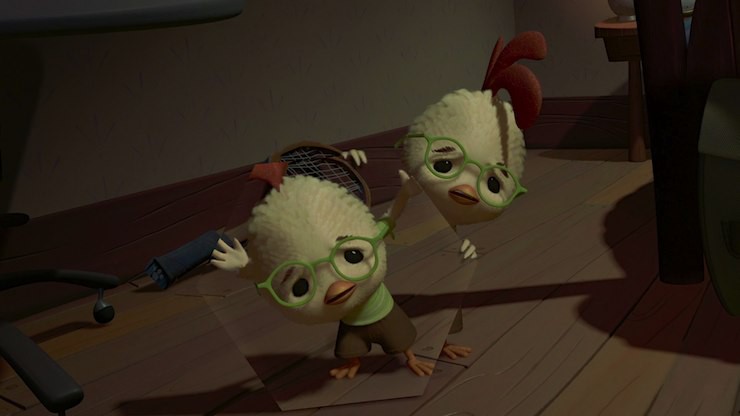
And this is all before we get to the plot holes. I’ve picked two, just to illustrate:
Plot Hole One: In the beginning of the film, Chicken Little is hit on the head by a large mysterious object shaped like a stop sign that fell from the sky. No one, including Chicken Little, can find it, so his father assumes that Chicken Little was just hit on the head by an acorn, and so sorry for alarming the entire town and causing several accidents and rather severe damage to the movie theatre. Fair enough.
Except that, when Chicken Little is later hit on the head by a second large mysterious object shaped like a stop sign, he trips on it seconds later. It’s able to blend visually into its surroundings—Chicken Little trips on it because it looks like part of the wooden floor—but not tangibly. Chicken Little is able to pick it up and move it around. Fish is later able to ride on top of it. Thus, this is something that Chicken Little (and others) should have tripped over both times, not just later, when it was convenient to the plot.
Sure, later scenes also show us that these large mysterious objects can fly back to the alien ship even if a fish is standing on them, so it’s highly possible that the thing just flew back to the ship—except that this brings up two more problems: 1, when the objects do fly around, the camouflaging part is on the top, the colorful, brilliantly lit electronic side is on the bottom, which means that it is perfectly visible to people on the ground (this is even a plot point) and 2, since these objects can fly, why are they falling on anyone?
Plot Hole Two: At the end, the aliens assure us that they visit Earth on a regular basis because they love the acorns and Earth is the only planet that has them. They’ve tried all the other planets, and by other planets, they mean Neptune, Uranus, Saturn, Jupiter, and Mars. This raises several questions, not least of them ok, so, if they are part of a galactic alliance, why are they only searching for acorns in one solar system, but, more importantly, they come every year. They speak English. They wear three-eyed Mickey Mouse watches (it’s a terrible visual joke, but that’s not the point here.) They love this place. So, why, exactly, is their first response to start blowing things up and teleporting people instead of, I don’t know, discreetly looking for their kid?
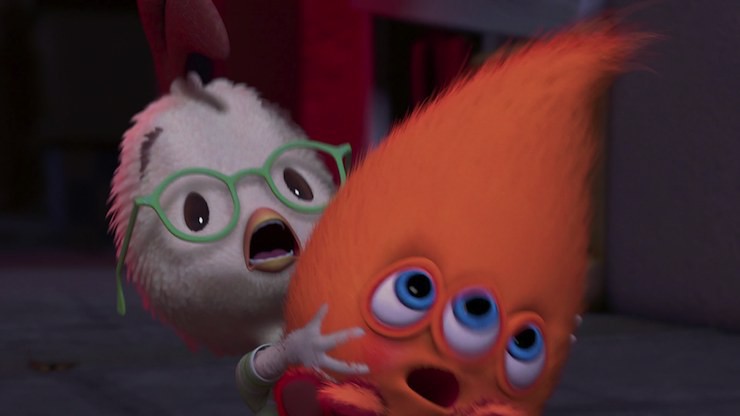
WTF moment of many: Having figured out that they need to get the alien baby back to the alien robots, Chicken Little takes the baby and….runs away with it. More than once. Not once does Chicken Little, or anyone else, consider bringing the alien baby to any of the MANY MANY frantic alien robots ON THE GROUND hunting for the baby. No: they have to do an elaborate scheme that involves climbing a tower and DANGLING THE BABY SEVERAL FEET OFF THE GROUND, even though it’s become increasingly clear that should ANYTHING happen to this baby, the entire planet will go BOOM.
I mean, would like to sympathize with Chicken Little. Really, I would. And from time to time—when, for instance, he’s in the back seat of the family car, trying to communicate with his father—I almost do. And I’ll be the first to grant that he has his moments of ingenuity. But decisions like the above make it difficult. The plain fact is, Chicken Little does endanger his town, more than once: the way he initially announces that the sky is falling (actually the arrival of the aliens on their annual acorn hunting trip, but let’s move on) results in, as the script and the images make clear, actual physical damage and harm. He’s not jailed for it, just tormented by his classmates and some of the adults, which is a bit worse, but then, rather than learning from this, when he has physical evidence of an alien invasion, instead of hanging on to his original evidence, grabbing something from the alien ship, taking a picture or two, or having his friends (who were not involved in the first incident and thus have a lot more credibility) go tell an adult what’s happening, he instead repeats the whole ringing the town alarm, then dragging a group of adults out to the alien ship—which of course takes off before anyone else can see it. Naturally, they see no reason to believe him.
Which leads to aliens disintegrating them just a few minutes later, not, Abby, because Chicken Little has failed to communicate with his father, but because he’s not just apparently learned nothing from his previous mistake and the vicious bullying that followed, but actually doubled down on it.
This is of course typical for Disney films, which often feature early moments the protagonist screwing up—badly—presumably to increase the emotional satisfaction of the protagonist’s eventual triumph. We tend, after all, to cheer for the underdog, and giving Hercules those initial moments of incredible clumsiness and the resulting destruction helped audiences connect with the character—especially since Disney couldn’t, for child-friendly reasons, feature any of the mythical Hercules screw-ups. But those protagonists all learned from these early mistakes, and didn’t repeat them. And those protagonists only wallowed in self-pity for a few seconds on screen. The problem with Chicken Little is that the mistakes aren’t limited to the beginning of the film: they keep coming, and coming and coming, and the second problem is that when Chicken Little finally does triumph (BY, LET’S REMEMBER, ENDANGERING A CUTE LITTLE ALIEN BABY), he triumphs not because he has learned anything from his initial screw-ups, which only served to make him feel sorry for himself, but by repeating some of his few successes from earlier in the film.
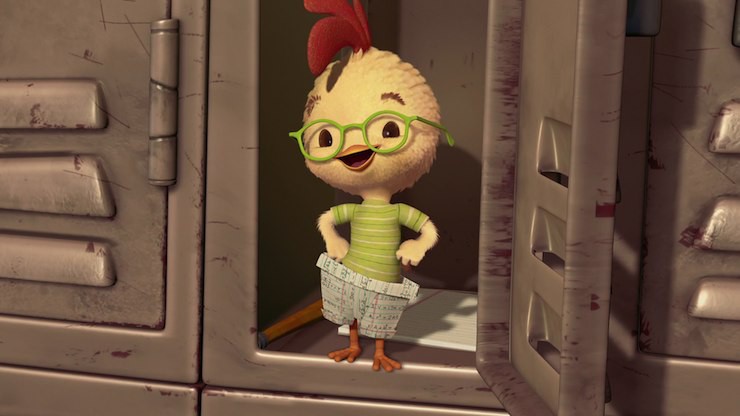
And even many of those triumphs—like his speedy creation of a pair of pants created from folded paper, after losing his original pair of pants to chewing gum—just raise more irritated questions. If, for example, losing his pants on the way to school thanks to constantly getting them attached to chewing gum is a common occurrence, to the point where he calls the gum his old nemesis, why, oh why, has he not started to bring along a new pair of pants? Why hasn’t his father noticed just how many of his pants go missing—not just damaged, missing. Given how cruel his classmates are to him, why do none of them mock his paper pants?
And then there’s the film’s visual issues. Some of this—notably the jerky or unnatural movements of background characters—can be blamed on the simple fact that this was the studio’s first computer animated film, and the artists were still mastering the techniques. Fair enough. But almost nothing in this film—backgrounds, character designs—looks, for the lack of a better word, pretty. In fact most of the time it looks pretty awful, if pretty brightly colored. Part of this is the character designs: Abby, admittedly, is supposed to look ugly, so I’ll handwave that, but I don’t understand why so many of the rabbits, who are supposed to look reasonably attractive, look like they’ve hopped in from a horror film next door.
It’s not that the film lacks its decent moments. I hate to admit it, but Fish Out of Water is kinda adorable, and has a decent King Kong moment. That has nothing to do with the rest of the film, but that’s also true for the entire first 30 minutes, so I’ll handwave it. Patrick Stewart gets to voice some terrible Sheep jokes, and both Wallace Shawn (aka Vizzini in The Princess Bride) and Patrick Warburton (aka The Tick) have fun in cameo roles. Sure, it’s stunt casting, as is bringing in Harry Shearer (probably best known on this site for This Is Spinal Tap and multiple voice roles on The Simpsons) and Adam West (the 1960s Batman series), but it works. I also like the porcupine, who does nothing but stand around and look cool, something I rather wish more of the characters had done. The song choices are all mostly fun, even if Chicken Little singing “We Are the Champions” was something I could have done without. And yes, I guess it’s great that the small little nerdy outsider manages to save the day and gets to watch a Hollywood action film based on his life ha ha.
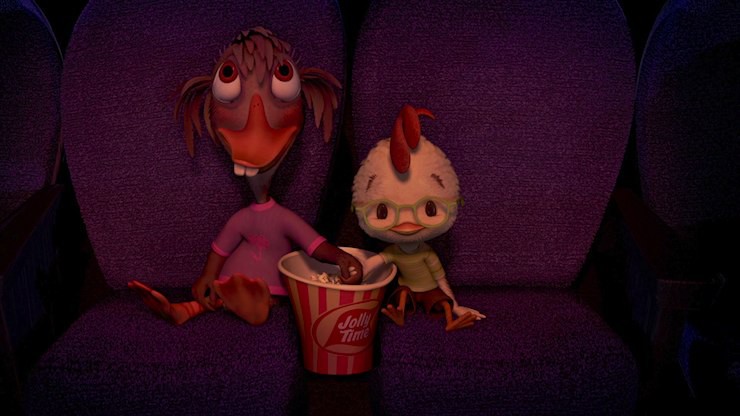
And yes, it’s also great to finally have a Disney film where the love interest isn’t a conventionally pretty girl, or even remotely physically attractive. It would have been EVEN BETTER if she had been less annoying, but I guess you can’t have everything.
But in some ways, these moments of—well, I can’t call them good, but let’s say watchable—bits only emphasize just how terrible the rest of the film is. And this is without even considering the multiple fat jokes, the way so many of the cultural references fall flat, and the extreme meanness of the film.
It’s this last, probably, that has led to this becoming possibly the longest post in this Read-Watch yet (well, that and the plot holes). Disney animated films had always, of course, contained moments of cruelty, moments of pain, moments of terror, moments of sorrow. But rarely—outside of Dumbo—mean.
And yet, a nasty undertone underscores nearly all of this film—and I’m not even talking about Abby’s insistence that it’s ok to let the aliens destroy the rest of the town as long as Chicken Little and his father FINALLY get to talk, although SHUT UP ABBY, or even the fat jokes. It’s the number of mean characters in a film that—despite my use of the word “mean”—doesn’t really have any villains. The way that the adults who aren’t bullying Chicken Little hastily pull their children out of his way, convinced that Chicken Little will harm their kids—and the way that they are almost certainly right. It’s the way that the film often seems to be inviting us to laugh at Chicken Little even as he’s being bullied at school, instead of with him. It’s the malicious joy the film often seems to take in humiliating its protagonists—except for Fish and that porcupine.
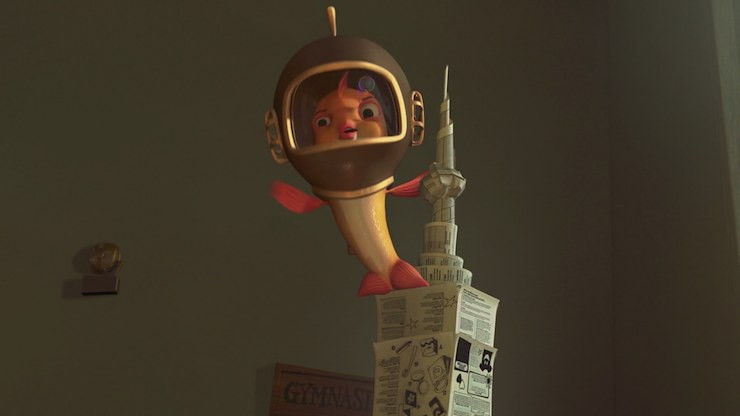
Seeing a Disney animated film become mean, become cruel—well, it’s not quite my all time most heartbreaking Disney film watching moment, or even my most infuriated (that’s coming up in a few more posts), but still, something inside me that loves these films died a little, watching this one.
The rest of me wanted to dig my eyeballs out with a spoon.
It’s only fair to note that audiences disagreed with me. Despite generally negative reviews, Chicken Little was a moderate box office success, earning $314.4 million worldwide—perhaps because it was released in 2005, one of the few years of that decade without a rival Pixar or Dreamworks film. Regardless of the reasons, this was considerably better than most of the other Disney films of that decade, and Disney made plans for a sequel, and released some assorted merchandise, including two video games.
But it was also still well below the box office totals for any of the six Pixar films, including the $363.4 million earned by A Bug’s Life in 1998 (the lowest for any Pixar film), and considerably below the $936.7 million earned by Finding Nemo in 2003 and $631.4 million pulled in by The Incredibles in 2004. It was also below the $484.4 million pulled in the chief inspiration for its success, Shrek.
And for Disney, it wasn’t enough.
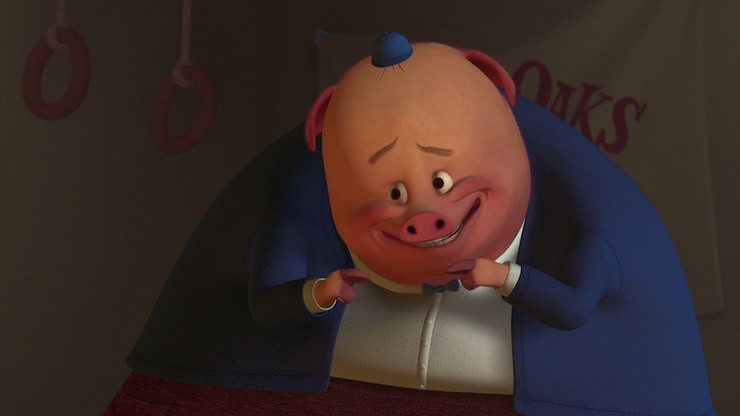
Incoming CEO Bob Iger—brought in by that Roy Disney “Save Disney” corporate takeover I mentioned earlier—studied the numbers.
He made another momentous decision: instead of trying to outdo rival Pixar, Disney would just purchase it instead.
The $7.4 billion all stock transaction was finished in May 2006. (As a fun comparison, the then-unheard of, almost bankrupting budget for Snow White and the Seven Dwarfs had been about $1.5 million.) As part of the deal, Pixar’s John Lasseter, once fired from Disney for focusing on computer animation, was appointed the Chief Creative Director of Walt Disney Animation Studios—entirely thanks to his decision to focus on computer animation.
One of Lasseter’s first decisions was to cancel the Chicken Little sequel. He did, however, allow animators to finish up Meet the Robinsons—already halfway completed.
Coming up next.
Note: Because the source text for Meet the Robinsons is so short—only 32 pages—we’ll be doing both in the same post.
Mari Ness lives in central Florida.










